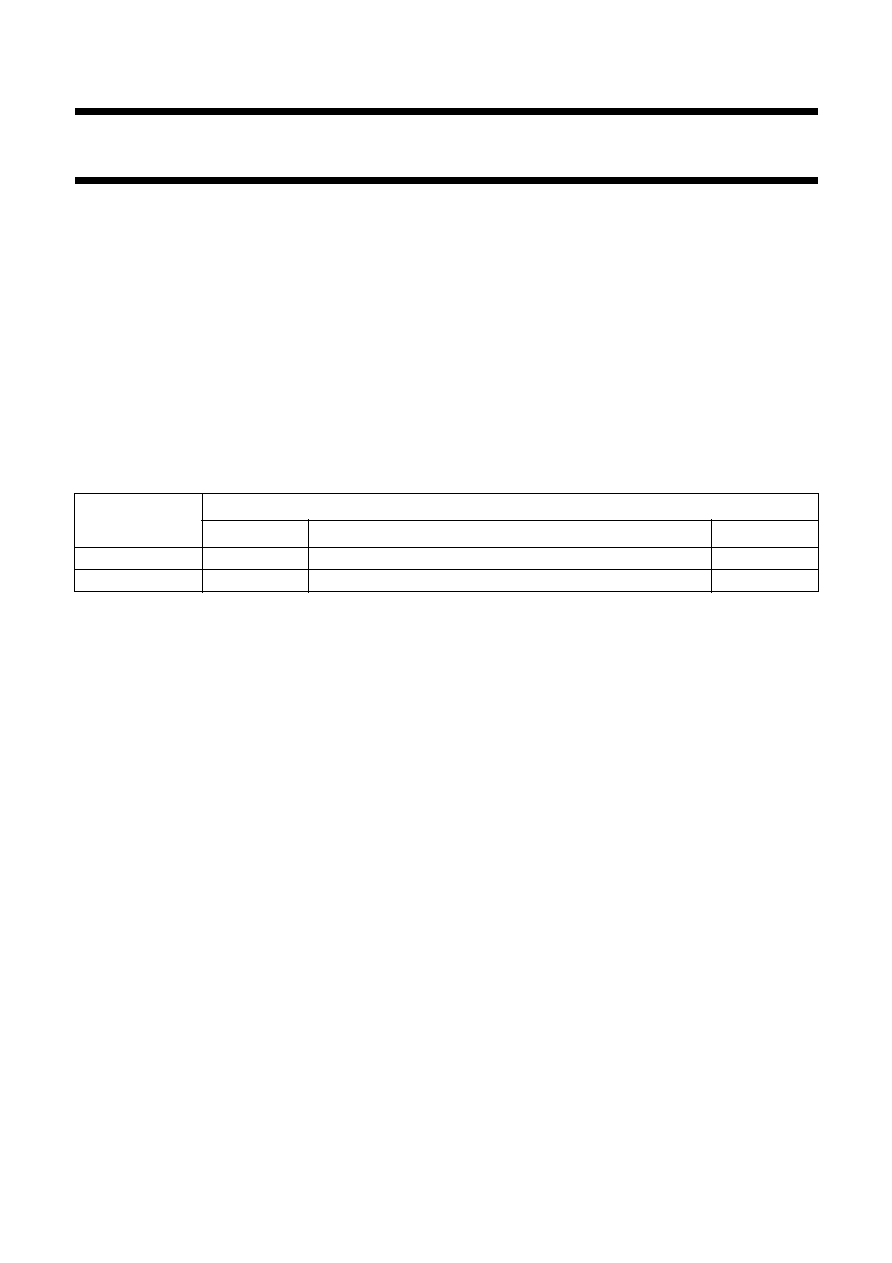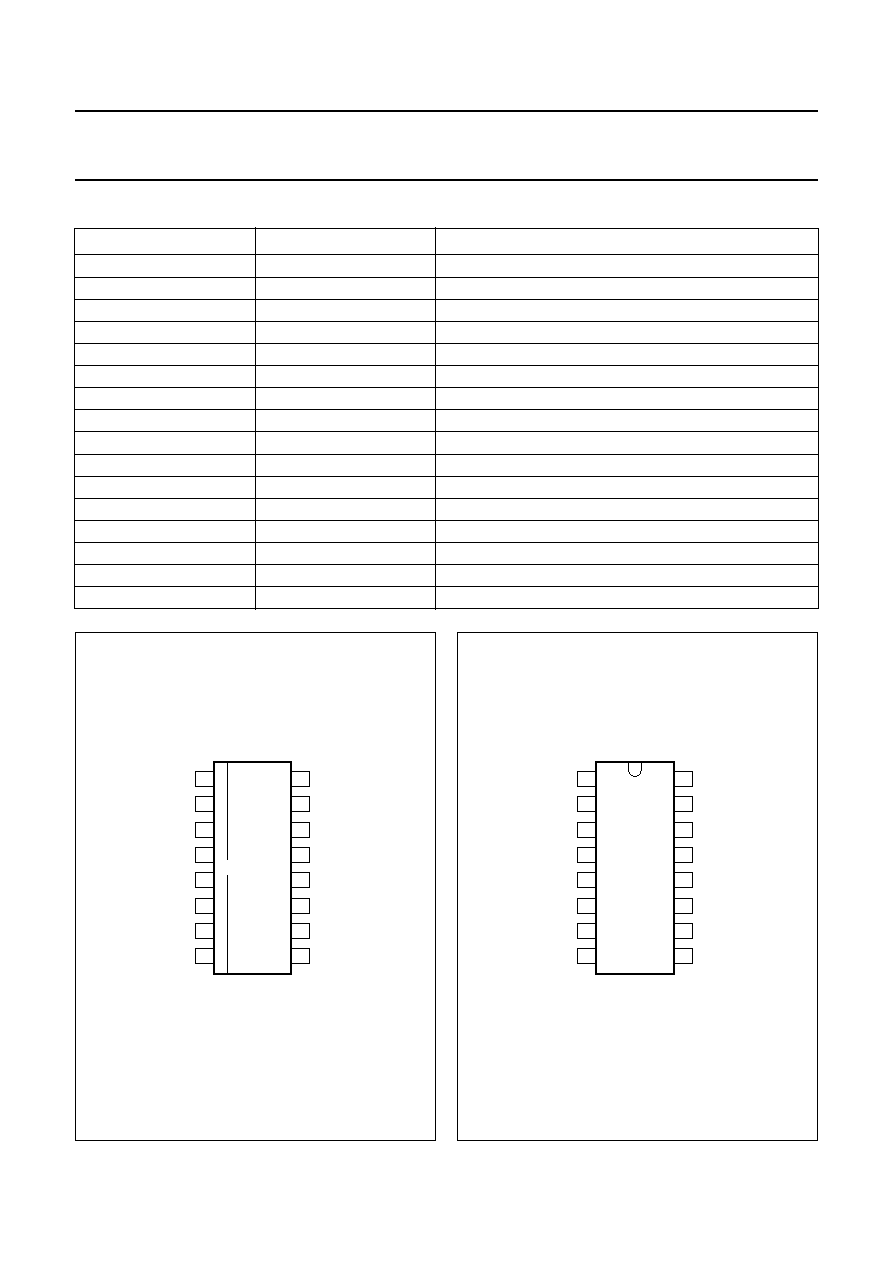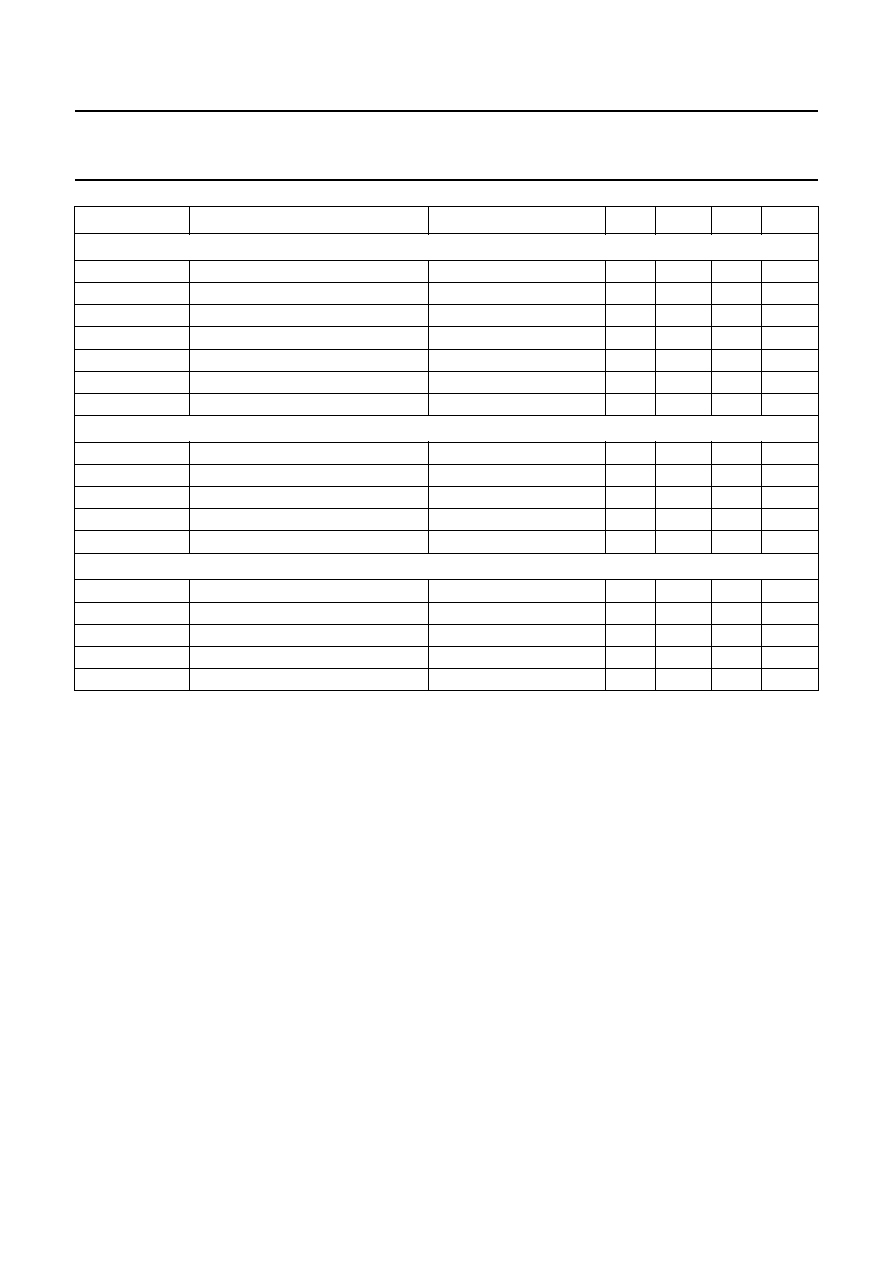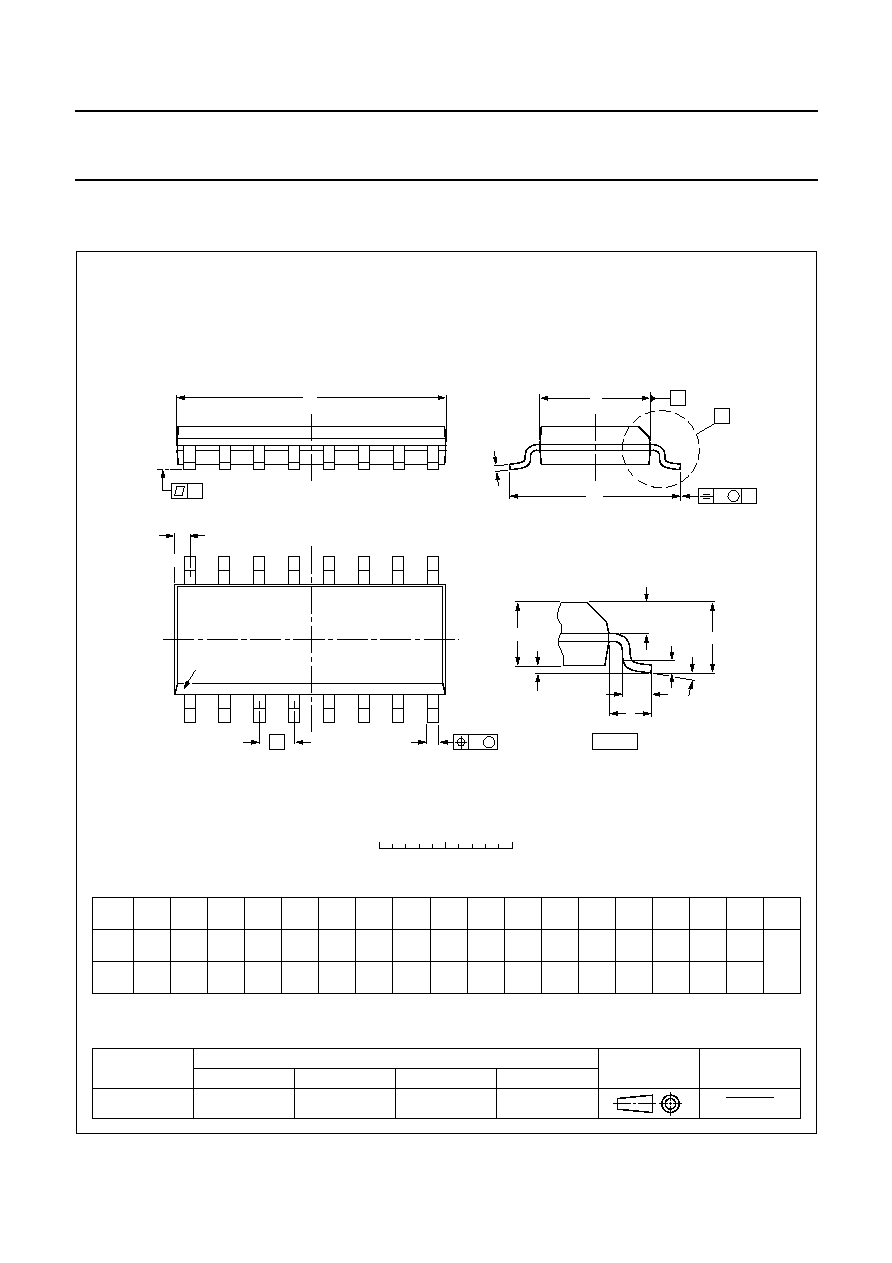 | –≠–ª–µ–∫—Ç—Ä–æ–Ω–Ω—ã–π –∫–æ–º–ø–æ–Ω–µ–Ω—Ç: UBA2070P | –°–∫–∞—á–∞—Ç—å:  PDF PDF  ZIP ZIP |
Document Outline
- FEATURES
- APPLICATION
- GENERAL DESCRIPTION
- ORDERING INFORMATION
- QUICK REFERENCE DATA
- BLOCK DIAGRAM
- PINNING
- FUNCTIONAL DESCRIPTION
- LIMITING VALUES
- THERMAL CHARACTERISTICS
- QUALITY SPECIFICATION
- CHARACTERISTICS
- PACKAGE OUTLINES
- SOLDERING
- DATA SHEET STATUS
- DEFINITIONS
- DISCLAIMERS

DATA SHEET
Product specification
Supersedes data of 2001 Sep 27
2002 Oct 24
INTEGRATED CIRCUITS
UBA2070
600 V CCFL ballast driver IC

2002 Oct 24
2
Philips Semiconductors
Product specification
600 V CCFL ballast driver IC
UBA2070
FEATURES
∑
Current controlled operation
∑
Adaptive non-overlap time control
∑
Integrated high voltage level shift function
∑
Power-down function
∑
Protected against lamp failures or lamp removal
∑
Capacitive mode protection.
APPLICATION
∑
The circuit topology enables a broad range of backlight
inverters.
GENERAL DESCRIPTION
The UBA2070 is a high voltage integrated circuit for driving
electronically ballasted Cold Cathode Fluorescent Lamps
(CCFL) at mains voltages up to 277 V (RMS) (nominal
value). The circuit is made in a 650 V Bipolar CMOS
DMOS (BCD) power logic process. The UBA2070
provides the drive function for the two discrete MOSFETs.
Besides the drive function the UBA2070 also includes the
level-shift circuit, the oscillator function, a lamp voltage
monitor, a current control function, a timer function and
protections.
ORDERING INFORMATION
TYPE NUMBER
PACKAGE
NAME
DESCRIPTION
VERSION
UBA2070T
SO16
plastic small outline package; 16 leads; body width 3.9 mm
SOT109-1
UBA2070P
DIP16
plastic dual in-line package; 16 leads (300 mil); long body
SOT38-1

2002 Oct 24
3
Philips Semiconductors
Product specification
600 V CCFL ballast driver IC
UBA2070
QUICK REFERENCE DATA
SYMBOL
PARAMETER
CONDITION
MIN.
TYP.
MAX.
UNIT
High voltage supply
V
hs
high side supply voltage
I
hs
< 30
µ
A; t < 1 s
-
-
600
V
Start-up state
V
DD(high)
oscillator start voltage
12.4
13
13.6
V
V
DD(low)
oscillator stop voltage
8.6
9.1
9.6
V
I
DD(start)
start-up current
V
DD
< V
DD(high)
-
170
200
µ
A
Reference voltage (pin V
REF
)
V
ref
reference voltage
I
L
= 10
µ
A
2.86
2.95
3.04
V
Voltage controlled oscillator
f
bridge(max)
maximum bridge frequency
90
100
110
kHz
f
bridge(min)
minimum bridge frequency
38.9
40.5
42.1
kHz
Output drivers (pins GH and GL)
I
source
source current
V
GH
-
V
SH
= 0; V
GL
= 0
135
180
235
mA
I
sink
sink current
V
GH
-
V
SH
= 13 V;
V
GL
= 13 V
265
300
415
mA
Lamp voltage sensor (pin LVS)
V
LVS(fail)
fail voltage level
1.19
1.25
1.31
V
V
LVS(max)
maximum voltage level
1.67
1.76
1.85
V
Average current sensor (pin CS)
V
offset
offset voltage
V
CS
= 0 to 2.5 V
-
2
0
+2
mV
g
m
transconductance
f = 1 kHz
100
200
400
µ
A/mV
Ignition timer (pin CT)
V
OL
LOW-level output voltage
-
1.4
-
V
V
OH
HIGH-level output voltage
-
3.6
-
V

2002
Oct
24
4
Philips Semiconductors
Product specification
600
V CCFL ballast dr
iv
er IC
UBA2070
This text is here in white to force landscape pages to be rotated correctly when browsing through the pdf in the Acrobat reader.This text is here in
_
white to force landscape pages to be rotated correctly when browsing through the pdf in the Acrobat reader.This text is here inThis text is here in
white to force landscape pages to be rotated correctly when browsing through the pdf in the Acrobat reader. white to force landscape pages to be ...
BLOCK DIA
GRAM
d
book, full pagewidth
MGT990
DRIVER
LOGIC
LEVEL
SHIFTER
BOOTSTRAP
FREQUENCY
CONTROL
AVERAGE
CURRENT
SENSOR
CS
+
15
GH
10
FVDD
9
CS
-
16
LOGIC
LAMP
VOLTAGE
SENSOR
VOLTAGE
CONTROLLED
OSCILLATOR
REFERENCE
CURRENT
I
V
GL
LS
DRIVER
HS
DRIVER
6
SH
11
ACM
12
IGNITION TIMER
STATE LOGIC
∑
reset state
∑
ignition state
∑
burn state
∑
hold state
∑
powerdown state
SUPPLY
VDD
VREF
reset
VDD(low)
VDD(clamp)
reference
voltages
digital
analog
supply (5 V)
3 V
7
14
LOGIC
1
4
CT
IREF
3
CF
13
LVS
2
CSW
5
GND
8
n.c.
VLVS(fail)
VLVS(max)
ANT/CMD
Fig.1 Block diagram.

2002 Oct 24
5
Philips Semiconductors
Product specification
600 V CCFL ballast driver IC
UBA2070
PINNING
SYMBOL
PIN
DESCRIPTION
CT
1
ignition timer output
CSW
2
voltage controlled oscillator input
CF
3
voltage controlled oscillator output
I
REF
4
internal reference current input
GND
5
ground
GL
6
gate of the low side switch output
V
DD
7
low voltage supply
n.c.
8
not connected
FV
DD
9
floating supply; supply for the high side switch
GH
10
gate of the high side switch output
SH
11
source of the high side switch
ACM
12
capacitive mode input
LVS
13
lamp voltage sensor input
V
REF
14
reference voltage output
CS+
15
average current sensor positive input
CS
-
16
average current sensor negative input
handbook, halfpage
UBA2070T
MGT985
1
2
3
4
5
6
7
8
16
15
14
13
12
11
10
9
CT
CSW
CF
IREF
GND
GL
VDD
n.c.
FVDD
GH
SH
ACM
LVS
VREF
CS
+
CS
-
Fig.2 Pin configuration (SO16).
handbook, halfpage
UBA2070P
MGT984
1
2
3
4
5
6
7
8
16
15
14
13
12
11
10
9
CT
CSW
CF
IREF
GND
GL
VDD
n.c.
FVDD
GH
SH
ACM
LVS
VREF
CS
+
CS
-
Fig.3 Pin configuration (DIP16).

2002 Oct 24
6
Philips Semiconductors
Product specification
600 V CCFL ballast driver IC
UBA2070
FUNCTIONAL DESCRIPTION
Start-up state
Initial start-up can be achieved by charging C
VDD
using an
external start-up resistor. The start-up of the circuit is such,
that the MOSFETs T
ls
and T
hs
shall be non-conductive.
The circuit will be reset in the start-up state. If the V
DD
supply reaches the value of V
DD(high)
the circuit starts
oscillating. A DC reset circuit is incorporated in the high
side (hs) driver. Below the lockout voltage at pin FV
DD
the
output voltage (V
GH
-
V
SH
) is zero. The voltages at pins
CF and CT are zero during the start-up state.
Oscillation
The internal oscillator is a Voltage Controlled Oscillator
circuit (VCO) which generates a sawtooth waveform
between the high level at pin CF and 0 V (see Fig.4). The
frequency of the sawtooth is determined by C
CF
,
R
IREF
and the voltage at pin CSW. The minimum and
maximum frequencies are determined by C
CF
and R
IREF
.
The minimum to maximum ratio is fixed internally. The
sawtooth frequency is twice the half bridge frequency. The
IC brings the MOSFETs T
hs
and T
ls
alternately into
conduction with a duty factor of 50%.The oscillator starts
oscillating at f
max
. During the first switching cycle the
MOSFET T
ls
is switched on. To charge the bootstrap
capacitor the first conduction time after the start-up state is
made extra long. In all other cases the duty factor at the
start is 50%.
Non-overlap time
The non-overlap time is realized with an Adaptive
Non-Overlap circuit (ANT). By using this circuit, the
application determines the duration of the non-overlap
time (determined by the slope of the half bridge voltage
and detected by the signal across R
ACM
) and makes the
non-overlap time optimum for each frequency (see Fig.4).
The minimum non-overlap time is internally fixed. The
maximum non-overlap time is internally fixed at
approximately 25% of the bridge period time.
Timing circuit
A timing circuit is included (a clock generator) to determine
the maximum ignition time. The ignition time is defined as
1 pulse at pin CT; the lamp has to ignite within the duration
of this pulse. The timer circuit starts operating when a
critical value of the lamp voltage [V
LVS(fail)
] is exceeded.
When the timer is not operating the capacitor at pin CT is
discharged by 1 mA to 0 V.
Ignition state
After the start at f
max
the frequency will decrease due to
charging the capacitor at pin CSW with an internally fixed
current. During this continuous decrease in frequency, the
circuit approaches the resonant frequency of the lamp.
This will cause a high voltage across the lamp, which
ignites the lamp. The ignition voltage of the lamp is
designed to be above the V
LVS(fail)
level. If the lamp voltage
exceeds this voltage level the ignition timer is started (see
Fig.5).
Burn state
If the lamp voltage does not exceed the V
LVS(max)
level the
voltage at pin CSW will continue to increase until the
clamp level at pin CSW is reached. As a consequence the
frequency will decrease until the minimum frequency is
reached. When the frequency reaches its minimum level it
is assumed that the lamp has ignited, the circuit will enter
the burn state and the Average Current Sensor (ACS)
circuit will be enabled (see Fig.5). As soon as the average
voltage across R
sense
(measured at pin CS
-
) reaches the
reference level at pin CS+, the average current sensor
circuit will take over the control of the lamp current. The
average current through R
sense
is transferred to a voltage
at the voltage controlled oscillator to regulate the
frequency and, as a result, the lamp current.
Lamp failure
D
URING IGNITION STATE
If the lamp fails to ignite, the voltage level increases. When
the lamp voltage exceeds the V
LVS(max)
level, the voltage
will be regulated at that level. The ignition timer is started
when the V
LVS(fail)
level is exceeded. If the voltage at
pin LVS is above the V
LVS(fail)
level at the end of the
ignition time the circuit stops oscillation and is forced into
a Power-down state (see Fig.6). This state is terminated by
switching off the V
DD
supply.
D
URING BURN STATE
If the lamp fails during normal operation, the voltage
across the lamp will increase and the lamp voltage will
exceed the V
LVS(fail)
level. This forces the circuit to re-enter
the ignition state and results in an attempt to re-ignite the
lamp. If during restart the lamp still fails, the voltage
remains high until the end of the ignition time. At the end
of the ignition time the circuit stops oscillating and enters
the Power-down state (see Fig.7).

2002 Oct 24
7
Philips Semiconductors
Product specification
600 V CCFL ballast driver IC
UBA2070
handbook, full pagewidth
MGT989
CF
GL
GH-SH
0
0
0
t
0
0
VACM
Vhalf bridge
VCMD
+
VCMD
-
Fig.4 Oscillator and driver timing.
handbook, full pagewidth
MGT986
Burn state
Ignition state
start timer
stop timer
fmin detection
Timer
on
t
off
VLVS(fail)
VLVS(max)
VLVS
Fig.5 Normal ignition behaviour.

2002 Oct 24
8
Philips Semiconductors
Product specification
600 V CCFL ballast driver IC
UBA2070
handbook, full pagewidth
MGT987
Power-down
Ignition state
start timer
Timer
on
t
off
VLVS(fail)
VLVS(max)
VLVS
Fig.6 Lamp failure during ignition state.
handbook, full pagewidth
MGT988
Power-down
Burn state
Ignition
start timer
Timer
on
t
off
VLVS(fail)
VLVS(max)
VLVS
Fig.7 Lamp failure during burn state.

2002 Oct 24
9
Philips Semiconductors
Product specification
600 V CCFL ballast driver IC
UBA2070
Power-down state
The Power-down state will be entered if, at the end of the
ignition time, the voltage at pin LVS is above V
LVS(fail)
.
In the Power-down state the oscillation will be stopped and
MOSFETs T
hs
and T
ls
will be non-conductive. The V
DD
supply is internally clamped. The circuit is released from
the Power-down state by reducing the supply voltage to
below V
DD(reset)
.
Capacitive mode protection
The signal across R
ACM
also gives information about the
switching behaviour of the half bridge. If the voltage at
R
ACM
does not exceed the V
CMD
level during the
non-overlap time (see Fig.4), the Capacitive Mode
Detection (CMD) circuit assumes that the circuit is in
capacitive mode of operation. Consequently the frequency
will be directly increased to f
max
. In this event the
frequency behaviour is decoupled from the voltage at
pin CSW until the voltage is discharged to zero. An internal
filter of 30 ns is included at pin ACM to increase the noise
immunity.
Charge coupling
Due to parasitic capacitive coupling to the high voltage
circuitry all pins are charged with a repetitive charge
injection. Given the typical application the pins
I
REF
and CF are sensitive to this charge injection. For
charge coupling of
±
8 pC, a safe functional operation of
the IC is guaranteed, independent of the current level.
Charge coupling at current levels below 50
µ
A will not
interfere with the accuracy of the V
CS
and V
ACM
levels.
Charge coupling at current levels below 20
µ
A will not
interfere with the accuracy of any parameter.
LIMITING VALUES
In accordance with the Absolute Maximum Rating System (IEC 60134); all voltages referenced to ground.
Note
1. In accordance with the human body model: equivalent to discharging a 100 pF capacitor through a 1.5 k
series
resistor.
SYMBOL
PARAMETER
CONDITION
MIN.
MAX.
UNIT
V
hs
high side supply voltage
I
hs
< 30
µ
A; t < 1 s
-
600
V
I
hs
< 30
µ
A
-
510
V
V
ACM
voltage on pin ACM
-
5
+5
V
V
LVS
voltage on pin LVS
0
5
V
V
CS+
voltage on pin CS+
0
5
V
V
CS
-
voltage on pin CS
-
-
0.3
+5
V
V
CSW
voltage on pin CSW
0
5
V
T
amb
ambient temperature
-
25
+80
∞
C
T
j
junction temperature
-
25
+150
∞
C
T
stg
storage temperature
-
55
+150
∞
C
V
esd
electrostatic discharge voltage
note 1
pins FV
DD
, GH, SH and V
DD
-
1000
+1000
V
pins GL, ACM, CS+, CS
-
, CSW,
LVS, CF, I
REF
, CT and V
REF
-
2500
+
2500
V

2002 Oct 24
10
Philips Semiconductors
Product specification
600 V CCFL ballast driver IC
UBA2070
THERMAL CHARACTERISTICS
QUALITY SPECIFICATION
In accordance with
"SNW-FQ-611D".
CHARACTERISTICS
V
DD
= 13 V, V
FVDD
-
V
SH
= 13 V; T
amb
= 25
∞
C; all voltages referenced to ground; see Fig.8; unless otherwise specified.
SYMBOL
PARAMETER
DESCRIPTION
VALUE
UNIT
R
th(j-a)
thermal resistance from junction to ambient in free air
SO16
100
K/W
DIP16
60
K/W
R
th(j-t)
thermal resistance from junction to tie-point
SO16
50
K/W
DIP16
30
K/W
SYMBOL
PARAMETER
CONDITION
MIN.
TYP.
MAX.
UNIT
High voltage supply
I
L
leakage current on high voltage pins voltage at pins FV
DD
,
GH and SH = 600 V
-
-
30
µ
A
Start-up state (pin V
DD
)
V
DD
supply voltage for defined driver
output
T
hs
= off; T
ls
= off
-
-
6
V
V
DD(high)
oscillator start voltage
12.4
13
13.6
V
V
DD(low)
oscillator stop voltage
8.6
9.1
9.6
V
V
DD(hys)
start-stop hysteresis voltage
3.5
3.9
4.4
V
I
DD(start)
start-up current
V
DD
< V
DD(high)
-
170
200
µ
A
V
DD(clamp)
clamp voltage
Power-down mode
10
11
12
V
I
DD(pd)
Power-down current
V
DD
= 9 V
-
170
200
µ
A
V
DD(reset
)
reset voltage
T
hs
= off; T
ls
= off
4.5
5.5
7
V
I
DD
operating supply current
f
bridge
= 40 kHz without
gate drive
-
1.5
2.2
mA
Reference voltage (pin V
REF
)
V
ref
reference voltage
I
L
= 10
µ
A
2.86
2.95
3.04
V
I
ref
reference current
source
1
-
-
mA
sink
1
-
-
mA
Z
o
output impedance
I
L
= 1 mA source
-
3
-
V
ref
/
T
temperature coefficient of V
ref
I
L
= 10
µ
A;
T
amb
= 25 to 150
∞
C
-
-
0.64
-
%/K
Current supply (pin I
REF
)
V
I
input voltage
-
2.5
-
V
I
I
input current
65
-
95
µ
A

2002 Oct 24
11
Philips Semiconductors
Product specification
600 V CCFL ballast driver IC
UBA2070
Voltage controlled oscillator
t
start
first output oscillator stroke
after start-up state only
-
50
-
µ
s
f
bridge(max)
maximum bridge frequency
90
100
110
kHz
f
bridge(min)
minimum bridge frequency
38.9
40.5
42.1
kHz
f
stab
frequency stability
T
amb
=
-
20 to +80
∞
C
-
1.3
-
%
t
no(min)
minimum non-overlap time
GH to GL
0.68
0.90
1.13
µ
s
GL to GH
0.75
1
1.25
µ
s
t
no(max)
maximum non-overlap time
at f
bridge
= 40 kHz; note 1
-
6.7
-
µ
s
P
IN
CSW
V
i
input voltage
2.7
3
3.3
V
V
clamp
clamp voltage
burn state
2.8
3.1
3.4
V
P
IN
CF
I
start
start current
V
CF
= 1.5 V
3.8
4.5
5.2
µ
A
I
min
minimum current
V
CF
= 1.5 V
-
21
-
µ
A
I
max
maximum current
V
CF
= 1.5 V
-
54
-
µ
A
V
OH
HIGH-level output voltage
f = f
min
-
2.5
-
V
Output drivers
V
boot
bootstrap diode forward drop
I = 5 mA
1.3
1.7
2.1
V
V
FVDD
lockout voltage on pin FV
DD
2.8
3.5
4.2
V
I
FVDD
floating well supply current on
pin FV
DD
DC level at
V
GH
-
V
SH
= 13 V
-
35
-
µ
A
P
INS
GH
AND
GL
I
source
source current
V
GH
-
V
SH
= 0; V
GL
= 0
135
180
235
mA
I
sink
sink current
V
GH
-
V
SH
= 13 V;
V
GL
= 13 V
265
300
415
mA
V
OH
HIGH-level output voltage
I
o
= 10 mA
12.5
-
-
V
V
OL
LOW-level output voltage
I
o
= 10 mA
-
-
0.5
V
HIGH SIDE AND LOW SIDE
R
on
on resistance
I
o
= 10 mA
32
39
45
R
off
off resistance
I
o
= 10 mA
16
21
26
Adaptive non-overlap timing and capacitive mode detection (pin ACM)
I
i
input current
V
ACM
= 1.25 V
-
-
1
µ
A
V
det
capacitive mode detection voltage
positive
80
100
120
mV
negative
-
68
-
85
-
102
mV
SYMBOL
PARAMETER
CONDITION
MIN.
TYP.
MAX.
UNIT

2002 Oct 24
12
Philips Semiconductors
Product specification
600 V CCFL ballast driver IC
UBA2070
Note
1. The maximum non-overlap time is determined by the level of the CF signal. If this signal exceeds a level of 1.25 V
the non-overlap will end. This equals a maximum non-overlap time of 6.7
µ
s at a bridge frequency of 40 kHz.
Lamp voltage sensor (pin LVS)
I
i
input current
V
LVS
= 1.25 V
-
-
1
µ
A
V
LVS(fail)
fail voltage
1.19
1.25
1.31
V
V
LVS(fail)(hys)
fail voltage hysteresis
112
140
168
mV
V
LVS(fail)(hys)
/
T
temperature coefficient hysteresis
-
0.65
-
mV/K
V
LVS(max)
maximum voltage
1.67
1.76
1.85
V
I
o(sink)
output sink current
V
CSW
= 2 V
2.8
3.2
3.6
µ
A
I
o(source)(ign)
ignition output source current
V
CSW
= 2 V
9.0
10
11
µ
A
Average current sensor (pins CS+ and CS
-
)
I
i
input current
V
CS
= 0 V
-
-
1
µ
A
V
offset
offset voltage
V
CS
= 0 to 2.5 V
-
2
0
+2
mV
I
o(source)
output source current
V
CSW
= 2.0 V
9.0
10
11
µ
A
I
o(sink)
output sink current
V
CSW
= 2.0 V
9.0
10
11
µ
A
g
m
transconductance
f = 1 kHz
100
200
400
µ
A/mV
Ignition timer (pin CT)
I
o
output current
V
CT
= 2.5 V
5.5
5.9
6.3
µ
A
V
OL
LOW-level output voltage
-
1.4
-
V
V
OH
HIGH-level output voltage
-
3.6
-
V
V
hys
output hysteresis
2.05
2.20
2.35
V
t
ign
ignition time
-
0.257
-
s
SYMBOL
PARAMETER
CONDITION
MIN.
TYP.
MAX.
UNIT

2002
Oct
24
13
Philips Semiconductors
Product specification
600
V CCFL ballast dr
iv
er IC
UBA2070
This text is here in white to force landscape pages to be rotated correctly when browsing through the pdf in the Acrobat reader.This text is here in
_
white to force landscape pages to be rotated correctly when browsing through the pdf in the Acrobat reader.This text is here inThis text is here in
white to force landscape pages to be rotated correctly when browsing through the pdf in the Acrobat reader. white to force landscape pages to be ...
APPLICA
TION AND TEST INFORMA
TION
n
dbook, full pagewidth
MGT991
RIREF
33 k
VREF
FVDD
DVDD
ZVDD
13 V
GH
SH
GL
ACM
1
7
LVS
CS
-
CS
+
VDD
CT
9
10
11
6
4
5
3
2
14
12
13
16
15
CSW
CF
GND
IREF
CCF
100 pF
CCSW
220 nF
Cpwr
1 nF
Cres2
1 nF
Clamp1
47 pF
Clamp2
47 pF
Cres1
1 nF
CLVS3
56 nF
CLVS2
8.2 nF
CBR2
18 nF
CDC
220 nF
CBR1
1 nF
Cboot
100 nF
CCT
330 nF
CVDD
1
µ
F
VDC
300 V
UBA2070
HIGH SIDE
DRIVER
LOW SIDE
DRIVER
BOOTSTRAP
DRIVER
CONTROL
SUPPLY
IGNITION
TIMER
REFERENCE
CURRENT
DIVIDER
ADAPTIVE
NON-OVERLAP
TIMING
CAPACITIVE
MODE DETECTOR
LAMP
VOLTAGE
SENSOR
-
+
+
AVERAGE
CURRENT
SENSOR
VOLTAGE
CONTROLLED
OSCILLATOR
RVDD
470 k
Rpwr2
8.2 k
RLVS
150 k
DLVS2
DLVS1
Lamp1
RACM
1.5
Rpwr1
220 k
CLVS1
8.2 nF
Ravg
8.2 k
RGH
Ths
Tls
47
Cavg
12 nF
Rsense
2.2
RGL
47
Lamp2
Fig.8 Test application circuit.

2002 Oct 24
14
Philips Semiconductors
Product specification
600 V CCFL ballast driver IC
UBA2070
PACKAGE OUTLINES
X
w
M
A
A
1
A
2
b
p
D
H
E
L
p
Q
detail X
E
Z
e
c
L
v
M
A
(A )
3
A
8
9
1
16
y
pin 1 index
UNIT
A
max.
A
1
A
2
A
3
b
p
c
D
(1)
E
(1)
(1)
e
H
E
L
L
p
Q
Z
y
w
v
REFERENCES
OUTLINE
VERSION
EUROPEAN
PROJECTION
ISSUE DATE
IEC
JEDEC
EIAJ
mm
inches
1.75
0.25
0.10
1.45
1.25
0.25
0.49
0.36
0.25
0.19
10.0
9.8
4.0
3.8
1.27
6.2
5.8
0.7
0.6
0.7
0.3
8
0
o
o
0.25
0.1
DIMENSIONS (inch dimensions are derived from the original mm dimensions)
Note
1. Plastic or metal protrusions of 0.15 mm maximum per side are not included.
1.0
0.4
SOT109-1
97-05-22
99-12-27
076E07
MS-012
0.069
0.010
0.004
0.057
0.049
0.01
0.019
0.014
0.0100
0.0075
0.39
0.38
0.16
0.15
0.050
1.05
0.041
0.244
0.228
0.028
0.020
0.028
0.012
0.01
0.25
0.01
0.004
0.039
0.016
0
2.5
5 mm
scale
SO16: plastic small outline package; 16 leads; body width 3.9 mm
SOT109-1

2002 Oct 24
15
Philips Semiconductors
Product specification
600 V CCFL ballast driver IC
UBA2070
UNIT
A
max.
1
2
b
1
c
E
e
M
H
L
REFERENCES
OUTLINE
VERSION
EUROPEAN
PROJECTION
ISSUE DATE
IEC
JEDEC
EIAJ
mm
inches
DIMENSIONS (inch dimensions are derived from the original mm dimensions)
SOT38-1
95-01-19
99-12-27
A
min.
A
max.
b
max.
w
M
E
e
1
1.40
1.14
0.055
0.045
0.53
0.38
0.32
0.23
21.8
21.4
0.86
0.84
6.48
6.20
0.26
0.24
3.9
3.4
0.15
0.13
0.254
2.54
7.62
0.30
8.25
7.80
0.32
0.31
9.5
8.3
0.37
0.33
2.2
0.087
4.7
0.51
3.7
0.15
0.021
0.015
0.013
0.009
0.01
0.10
0.020
0.19
050G09
MO-001
SC-503-16
M
H
c
(e )
1
M
E
A
L
seating plane
A
1
w
M
b
1
e
D
A
2
Z
16
1
9
8
b
E
pin 1 index
0
5
10 mm
scale
Note
1. Plastic or metal protrusions of 0.25 mm maximum per side are not included.
(1)
(1)
D
(1)
Z
DIP16: plastic dual in-line package; 16 leads (300 mil); long body
SOT38-1

2002 Oct 24
16
Philips Semiconductors
Product specification
600 V CCFL ballast driver IC
UBA2070
SOLDERING
Introduction
This text gives a very brief insight to a complex technology.
A more in-depth account of soldering ICs can be found in
our
"Data Handbook IC26; Integrated Circuit Packages"
(document order number 9398 652 90011).
There is no soldering method that is ideal for all IC
packages. Wave soldering is often preferred when
through-hole and surface mount components are mixed on
one printed-circuit board. Wave soldering can still be used
for certain surface mount ICs, but it is not suitable for fine
pitch SMDs. In these situations reflow soldering is
recommended.
Through-hole mount packages
S
OLDERING BY DIPPING OR BY SOLDER WAVE
The maximum permissible temperature of the solder is
260
∞
C; solder at this temperature must not be in contact
with the joints for more than 5 seconds. The total contact
time of successive solder waves must not exceed
5 seconds.
The device may be mounted up to the seating plane, but
the temperature of the plastic body must not exceed the
specified maximum storage temperature (T
stg(max)
). If the
printed-circuit board has been pre-heated, forced cooling
may be necessary immediately after soldering to keep the
temperature within the permissible limit.
M
ANUAL SOLDERING
Apply the soldering iron (24 V or less) to the lead(s) of the
package, either below the seating plane or not more than
2 mm above it. If the temperature of the soldering iron bit
is less than 300
∞
C it may remain in contact for up to
10 seconds. If the bit temperature is between
300 and 400
∞
C, contact may be up to 5 seconds.
Surface mount packages
R
EFLOW SOLDERING
Reflow soldering requires solder paste (a suspension of
fine solder particles, flux and binding agent) to be applied
to the printed-circuit board by screen printing, stencilling or
pressure-syringe dispensing before package placement.
Several methods exist for reflowing; for example,
convection or convection/infrared heating in a conveyor
type oven. Throughput times (preheating, soldering and
cooling) vary between 100 and 200 seconds depending
on heating method.
Typical reflow peak temperatures range from
215 to 250
∞
C. The top-surface temperature of the
packages should preferable be kept below 220
∞
C for
thick/large packages, and below 235
∞
C for small/thin
packages.
W
AVE SOLDERING
Conventional single wave soldering is not recommended
for surface mount devices (SMDs) or printed-circuit boards
with a high component density, as solder bridging and
non-wetting can present major problems.
To overcome these problems the double-wave soldering
method was specifically developed.
If wave soldering is used the following conditions must be
observed for optimal results:
∑
Use a double-wave soldering method comprising a
turbulent wave with high upward pressure followed by a
smooth laminar wave.
∑
For packages with leads on two sides and a pitch (e):
≠ larger than or equal to 1.27 mm, the footprint
longitudinal axis is preferred to be parallel to the
transport direction of the printed-circuit board;
≠ smaller than 1.27 mm, the footprint longitudinal axis
must be parallel to the transport direction of the
printed-circuit board.
The footprint must incorporate solder thieves at the
downstream end.
∑
For packages with leads on four sides, the footprint must
be placed at a 45
∞
angle to the transport direction of the
printed-circuit board. The footprint must incorporate
solder thieves downstream and at the side corners.
During placement and before soldering, the package must
be fixed with a droplet of adhesive. The adhesive can be
applied by screen printing, pin transfer or syringe
dispensing. The package can be soldered after the
adhesive is cured.
Typical dwell time is 4 seconds at 250
∞
C.
A mildly-activated flux will eliminate the need for removal
of corrosive residues in most applications.
M
ANUAL SOLDERING
Fix the component by first soldering two
diagonally-opposite end leads. Use a low voltage (24 V or
less) soldering iron applied to the flat part of the lead.
Contact time must be limited to 10 seconds at up to
300
∞
C. When using a dedicated tool, all other leads can
be soldered in one operation within 2 to 5 seconds
between 270 and 320
∞
C.

2002 Oct 24
17
Philips Semiconductors
Product specification
600 V CCFL ballast driver IC
UBA2070
Suitability of IC packages for wave, reflow and dipping soldering methods
Notes
1. For more detailed information on the BGA packages refer to the
"(LF)BGA Application Note" (AN01026); order a copy
from your Philips Semiconductors sales office.
2. All surface mount (SMD) packages are moisture sensitive. Depending upon the moisture content, the maximum
temperature (with respect to time) and body size of the package, there is a risk that internal or external package
cracks may occur due to vaporization of the moisture in them (the so called popcorn effect). For details, refer to the
Drypack information in the
"Data Handbook IC26; Integrated Circuit Packages; Section: Packing Methods".
3. For SDIP packages, the longitudinal axis must be parallel to the transport direction of the printed-circuit board.
4. These packages are not suitable for wave soldering. On versions with the heatsink on the bottom side, the solder
cannot penetrate between the printed-circuit board and the heatsink. On versions with the heatsink on the top side,
the solder might be deposited on the heatsink surface.
5. If wave soldering is considered, then the package must be placed at a 45
∞
angle to the solder wave direction.
The package footprint must incorporate solder thieves downstream and at the side corners.
6. Wave soldering is suitable for LQFP, QFP and TQFP packages with a pitch (e) larger than 0.8 mm; it is definitely not
suitable for packages with a pitch (e) equal to or smaller than 0.65 mm.
7. Wave soldering is suitable for SSOP and TSSOP packages with a pitch (e) equal to or larger than 0.65 mm; it is
definitely not suitable for packages with a pitch (e) equal to or smaller than 0.5 mm.
MOUNTING
PACKAGE
(1)
SOLDERING METHOD
WAVE
REFLOW
(2)
DIPPING
Through-hole mount DBS, DIP, HDIP, SDIP, SIL
suitable
(3)
-
suitable
Surface mount
BGA, LBGA, LFBGA, SQFP, TFBGA, VFBGA not suitable
suitable
-
HBCC, HBGA, HLQFP, HSQFP, HSOP,
HTQFP, HTSSOP, HVQFN, HVSON, SMS
not suitable
(4)
suitable
-
PLCC
(5)
, SO, SOJ
suitable
suitable
-
LQFP, QFP, TQFP
not recommended
(5)(6)
suitable
-
SSOP, TSSOP, VSO
not recommended
(7)
suitable
-

2002 Oct 24
18
Philips Semiconductors
Product specification
600 V CCFL ballast driver IC
UBA2070
DATA SHEET STATUS
Notes
1. Please consult the most recently issued data sheet before initiating or completing a design.
2. The product status of the device(s) described in this data sheet may have changed since this data sheet was
published. The latest information is available on the Internet at URL http://www.semiconductors.philips.com.
3. For data sheets describing multiple type numbers, the highest-level product status determines the data sheet status.
LEVEL
DATA SHEET
STATUS
(1)
PRODUCT
STATUS
(2)(3)
DEFINITION
I
Objective data
Development
This data sheet contains data from the objective specification for product
development. Philips Semiconductors reserves the right to change the
specification in any manner without notice.
II
Preliminary data Qualification
This data sheet contains data from the preliminary specification.
Supplementary data will be published at a later date. Philips
Semiconductors reserves the right to change the specification without
notice, in order to improve the design and supply the best possible
product.
III
Product data
Production
This data sheet contains data from the product specification. Philips
Semiconductors reserves the right to make changes at any time in order
to improve the design, manufacturing and supply. Relevant changes will
be communicated via a Customer Product/Process Change Notification
(CPCN).
DEFINITIONS
Short-form specification
The data in a short-form
specification is extracted from a full data sheet with the
same type number and title. For detailed information see
the relevant data sheet or data handbook.
Limiting values definition
Limiting values given are in
accordance with the Absolute Maximum Rating System
(IEC 60134). Stress above one or more of the limiting
values may cause permanent damage to the device.
These are stress ratings only and operation of the device
at these or at any other conditions above those given in the
Characteristics sections of the specification is not implied.
Exposure to limiting values for extended periods may
affect device reliability.
Application information
Applications that are
described herein for any of these products are for
illustrative purposes only. Philips Semiconductors make
no representation or warranty that such applications will be
suitable for the specified use without further testing or
modification.
DISCLAIMERS
Life support applications
These products are not
designed for use in life support appliances, devices, or
systems where malfunction of these products can
reasonably be expected to result in personal injury. Philips
Semiconductors customers using or selling these products
for use in such applications do so at their own risk and
agree to fully indemnify Philips Semiconductors for any
damages resulting from such application.
Right to make changes
Philips Semiconductors
reserves the right to make changes in the products -
including circuits, standard cells, and/or software -
described or contained herein in order to improve design
and/or performance. When the product is in full production
(status `Production'), relevant changes will be
communicated via a Customer Product/Process Change
Notification (CPCN). Philips Semiconductors assumes no
responsibility or liability for the use of any of these
products, conveys no licence or title under any patent,
copyright, or mask work right to these products, and
makes no representations or warranties that these
products are free from patent, copyright, or mask work
right infringement, unless otherwise specified.

2002 Oct 24
19
Philips Semiconductors
Product specification
600 V CCFL ballast driver IC
UBA2070
NOTES

© Koninklijke Philips Electronics N.V. 2002
SCA74
All rights are reserved. Reproduction in whole or in part is prohibited without the prior written consent of the copyright owner.
The information presented in this document does not form part of any quotation or contract, is believed to be accurate and reliable and may be changed
without notice. No liability will be accepted by the publisher for any consequence of its use. Publication thereof does not convey nor imply any license
under patent- or other industrial or intellectual property rights.
Philips Semiconductors ≠ a worldwide company
Contact information
For additional information please visit http://www.semiconductors.philips.com.
Fax: +31 40 27 24825
For sales offices addresses send e-mail to: sales.addresses@www.semiconductors.philips.com.
Printed in The Netherlands
613502/02/pp
20
Date of release:
2002 Oct 24
Document order number:
9397 750 10257



















